Bronze sculptures have existed globally for centuries, with the earliest examples dating back to 2500 BC. From small artworks and figurines through to life size statues and oversized extravagant displays of talent, bronze is unique in its ability to take in the finest of details from a cast, whilst having such strength in their structure that they can extend features beyond the capacity of ceramics or marble. However, the robust nature of bronze can be impacted by environmental reactions which compel deterioration and bring disturbance to the finish. Therefore, bronze sculpture restoration and care is an essential part of owning these artworks.
 Above: examples of bronze antiques including a bust, medallions, clasping hand sculpture, statuette of a panther & gilt bronze table clock
Above: examples of bronze antiques including a bust, medallions, clasping hand sculpture, statuette of a panther & gilt bronze table clock
Bronze artworks, when kept in the correct conditions, can last for hundreds of years without signs of significant damage, which is why it is important to monitor the atmosphere in which important pieces are kept. The impact of bronze deterioration can affect both the ongoing stability of the structure and the monetary or artistic value of the piece. This is why our trained conservators strive to restore and stabilise signs of decay as soon as they appear, minimising the damage caused.
 Above: a detail from a late 4th century BC box mirror with a youthful relief portrait of the woodland goat-god Pan
Above: a detail from a late 4th century BC box mirror with a youthful relief portrait of the woodland goat-god Pan
In this article we will discuss the history of bronze sculptures, artworks and items, including famous names to look out for. Our team will also offer bronze sculpture restoration advice on conservation methods, how to protect a bronze sculpture in your care and the perfect atmospheric conditions for preservation.
How are bronze sculptures made?
The process of creating a bronze sculpture can include many different methods of casting. The most common types are lost wax casting, centrifugal casting and sand casting. Lost wax casting, for example, has the artist create an initial model out of oil-based clay for smaller sculptures or water-based clay for larger pieces. Water-based clay is also used when the artist is trying to achieve an appearance of movement in the finished sculpture, known as a gestural quality. A soft cast is then made of the model, which has to be carefully stored afterwards (not becoming too dry) to ensure it can be used again if the casting fails.
 Above: engravings displaying the process of bronze casting, from left to right: the plaster cast process, a sculpture with support rods and wax drainage in place, and a foundry workshop
Above: engravings displaying the process of bronze casting, from left to right: the plaster cast process, a sculpture with support rods and wax drainage in place, and a foundry workshop
The bronze casting process usually fills an area around a void, making the finished product hollow. This is important because it improves both the weight of the finished sculpture and the overall cost to the patron or artist. Wax is then poured between this middle void and the mould, as it hardens the artist will usually sign the mould and date it, or a foundry stamps it with a trademark. The wax is placed in a stone surround which can withstand the heat, with wax rods to support it. These wax rods then melt away, draining the wax and allowing the bronze to set precisely into its place. Once cooled the mould is broken and the bronze is corrected where needed, and any areas where rods were fitted in the process are smoothed down. The final stage allows the surface to be carefully oxidised, this is a controlled process of corrosion to create a preferred patina or finish.
 Above: a detail from a Peder Severin Krøyer painting of a working foundry, 1885
Above: a detail from a Peder Severin Krøyer painting of a working foundry, 1885
How can I tell if a sculpture is made of real bronze?
Bronze consists of a mixture of metallic elements, often this is around 88% copper with 12% tin. However, archeological and antique bronze can be made up of many different elements, including in some cases a large amount of silver. Other variants in bronze include zinc, lead, iron, antimony, nickel and even arsenic. This is due to the craftsman using a variety of metal items to create their bronze object, such as coins, scrap metal and disused objects. Some bronze artworks may have a gilded layer on top known as ormolu.
 Above: examples of different patina colours you may find on a bronze, including warm brown, green and gilt finishes
Above: examples of different patina colours you may find on a bronze, including warm brown, green and gilt finishes
Some historic items known as bronze are in fact entirely brass. You can test to see if a sculpture or item is made of bronze by simply trying to apply a magnet, as this will stick more readily to brass due to a high level of zinc. You can also look at the surface of the metal – bronze will often have a glowing golden quality, whilst other metals may be dull and more prone to rust. A true patina on bronze will be part of the object, whilst other metals may have a faux-patina applied, which can rub off easily.
 Above: a true bronze bust from the 16th century next to a brass sculpture with faux green patina
Above: a true bronze bust from the 16th century next to a brass sculpture with faux green patina
The history and value of bronze sculptures
Specialist bronzes may be archeological, as bronze and brass artworks and items date back thousands of years and have served as inspiration to many great sculptors and artists over time. However, the most common pieces we see today are much later, notably sculptures from the 18th and 19th centuries and modern or contemporary installation pieces.
 Above: examples of ancient bronze horse statues and a cinerary urn from classical eras
Above: examples of ancient bronze horse statues and a cinerary urn from classical eras
Marcus Aurelius on horseback is one of the only surviving Roman bronze statues. This is due to an iconoclasm which happened in Europe during the medieval period, destroying any hints of “pagan” civilisation. All bronze images from the pre-Christian roman empire were sought out to be destroyed. The only reason this statue survived is because it was mistaken to represent the Christian emperor Constantine.
 Above: details from Lorenzo Ghiberti’s Florence baptistery door relief bronzes known as the Gates of Paradise, 15th century
Above: details from Lorenzo Ghiberti’s Florence baptistery door relief bronzes known as the Gates of Paradise, 15th century
Bronze saw a revival during the renaissance period, from the 15th century onwards in Italy there were foundries working in Florence and other major cities. From this era you may find the famous works of Lorenzo Ghiberti, including his masterpiece of the Florence baptistery doors including The Gates Of Paradise. Smaller statuettes were also created in this era, including popular scenes from ancient history which were to decorate private living spaces in grand homes.
 Above: a selection of bronze statuettes from the Italian renaissance period featuring typical classical allegory and characters
Above: a selection of bronze statuettes from the Italian renaissance period featuring typical classical allegory and characters
Bronzes from Florence in the 16th to 18th centuries were prized for an almost translucent lacquer with a red gold tone, this colouring still appeals to collectors today. Famous renaissance bronze sculptors such as Adriaen de Vries, Barthelemy Prieur, Willem van Tetrode and Hubert Gerhard continue to make huge sums at auction.
 Above: gilt bronze was popular in the baroque and rococo eras, this could be combined with dark bronze or even porcelain ornaments and is often found on clocks and candlesticks such as candelabrum
Above: gilt bronze was popular in the baroque and rococo eras, this could be combined with dark bronze or even porcelain ornaments and is often found on clocks and candlesticks such as candelabrum
Although the popularity of bronze began to wane again, it was reignited in the 18th century for gilt objects for the home and small decorative pieces. Bronze is often found in gilt candlesticks and chandeliers of this era, as well as wall appliques. During the industrial revolution of the 19th century, metal sculpture really began to take hold again due to advancements in technique. Paris was the centre of this bronze revival, with many artists moving to the French capital in order to specialise in a genre which allowed them to create various editions of their work.
 Above: 19th century bronze artworks – a polychrome bust with Algerian onyx-marble, bronze, gilt bronze, enamel, and amethyst eyes (left) and a medallion commemorating the Tercentenary of Trinity College Dublin in 1892 by Edmond Johnson
Above: 19th century bronze artworks – a polychrome bust with Algerian onyx-marble, bronze, gilt bronze, enamel, and amethyst eyes (left) and a medallion commemorating the Tercentenary of Trinity College Dublin in 1892 by Edmond Johnson
The most well known bronze sculptor of this period is Auguste Rodin, whose iconic artworks are still replicated to this day. Rodin’s most famous masterpieces include The Kiss, The Thinker and The Gates Of Hell. Rodin’s renowned sculptures clashed with traditional artistic ideals, that is the focus on classical mythology and allegorical themes being replaced with naturalism and individuality. Famous bronze sculptors from the 19th century and early 20th century include Camille Claudel, Antoine Bourdelle and Henri Matisse.
 Above: examples of Auguste Rodin’s bronzes including St. John the Baptist (1883), The Thinker (1910) and The Age of Bronze (1906)
Above: examples of Auguste Rodin’s bronzes including St. John the Baptist (1883), The Thinker (1910) and The Age of Bronze (1906)
As the 20th century continued, modern artists used the industrial nature of bronze to explore themes of machinery and futurism, as well as complex ideas about shape and form. This includes work by Umberto Boccioni, Jean Arp, Barbara Hepworth, Raymond Duchamp-Villon, Alberto Giacometti, Henry Moore, and Louise Bourgeois.
 Above: modern and contemporary bronze sculptures including works by Edgar Degas, Umberto Boccioni, David Cregeen and Alberto Giacometti
Above: modern and contemporary bronze sculptures including works by Edgar Degas, Umberto Boccioni, David Cregeen and Alberto Giacometti
How to care for bronze sculptures indoors & outdoors
It is often said of bronzes that their surface improves with age, with the patina becoming more beautiful over time. However, this depends on the original strength of the sculpture itself and the care it receives. Bronze sculptures and items should typically be kept in less than 40% humidity and if they are highly valuable you may want to consider placing them in a glass display case with a controlled environment.
 Above: corrosion on an 11th century Chinese cup
Above: corrosion on an 11th century Chinese cup
Over-polishing your bronze sculpture or item can actually reduce the value, as this may rub away centuries of maturing patina which is highly prized by collectors. Keep in mind that patina has often been purposefully created by the artist and removing it may completely disturb artistic and historic integrity. Never use metal polish or any other form of household cleaning product on bronze and avoid all forms of water. The only amount of cleaning that a bronze sculpture requires at home is the careful dusting of the surface, any build-up in crevices can be removed by a cotton bud. Do not touch bronze with your bare hands, as skin contains acids which may activate corrosion.
 Above: ancient bronze sculptures with signs of corrosion due to their age and changes in environment over centuries
Above: ancient bronze sculptures with signs of corrosion due to their age and changes in environment over centuries
Bronze is more resistant to corrosion and rusting than other metals, but it is possible that it will start to develop spots made up of cuprous chloride, known as ‘bronze disease’, or a powdery substance which keeps returning – this is active corrosion. Any sign of this requires treatment from a conservator and cannot be removed at home.
Bronze sculptures are at higher risk outside, where they face pollution, changes in weather and attacks from moisture or salts. Although it is common for exterior bronze sculptures to have a light green patina, which in fact protects it and adds some aesthetic value, in some cases this may be a sign of deterioration which needs to be addressed. If you are unsure of the stability or notice weakened areas, contact our team and consider taking the sculpture into a more sheltered location. Metal sculptures should be covered in wet months to avoid corrosion from trapped moisture.
 Above: a bronze sculpture with a typical green patina which has areas of corrosion from the atmosphere
Above: a bronze sculpture with a typical green patina which has areas of corrosion from the atmosphere
The most common form of decay to bronze sculptures is the denting of their surface as they are internally hollow. In the past some bronzes were filled with cement to try and stop this, but that may have actually damaged them further due to chemical reactions between the materials. Dents and holes should be assessed by our conservation team, rather than having extra materials added as a home fix. There are many chemicals which an untrained person may be unaware of, but may cause great harm to bronze, so this should always be a professional decision.
The restoration of a bronze bust
Our conservation team recently restored a bust of the poet and philosopher Dante, most likely dating back to the 19th century when such sculptures made for popular ‘grand tour’ souvenirs. The usual sunken look of the face is because these sculptures were based on Dante’s death mask which is preserved at the Florence town hall. Recent studies have suggested that this is not a true death mask, but was most likely carved in 1483 by Pietro and Tullio Lombardo (162 years after Dante’s death) but tourists in turn of the century Italy would not have known this and instead have prized it for morbidity and the true likeness of a great historical figure. The death mask was recently put into the spotlight again as a feature in Dan Brown’s Inferno and can still be viewed today at the Palazzo Vecchio.
 Above: the Dante bust before restoration work took place showing signs of deterioration
Above: the Dante bust before restoration work took place showing signs of deterioration
The Dante bust which came to our team’s attention was from the 19th Century and was known to be cast through the lost wax process by Sabatino de Angelis & Fils. This company was founded in 1840 and ran a bronze foundry in Naples from 1884 through to the early 20th century, they were also given permission to copy sculptures from the National Archeological Museum of Naples and so reproduced many ancient bronzes.
 Above: the original bust next to the finish which can be achieved through professional restoration
Above: the original bust next to the finish which can be achieved through professional restoration
The bronze bust required treatment due to areas of patina disturbance and surface deterioration due to being kept outside in the past. There were areas of orange left by lichen growth. Our conservator cleared away any contamination and returned an original patina for a safe and secure finish. This will allow for the bronze to be kept without fear of decay or further deterioration, as with the correct treatment and avoidance of moisture the sculpture should survive for hundreds of years into the future.
 Above: the Dante bust after restoration work and an improved, stable patina in keeping with the original finish
Above: the Dante bust after restoration work and an improved, stable patina in keeping with the original finish
How can we help?
If you have a bronze sculpture, artwork or item in need of conservation or restoration work, please contact our helpful team who will be pleased to assist you in saving a treasured item.
To make contact regarding a bronze sculpture restoration please email us via [email protected] or call 0207 112 7576

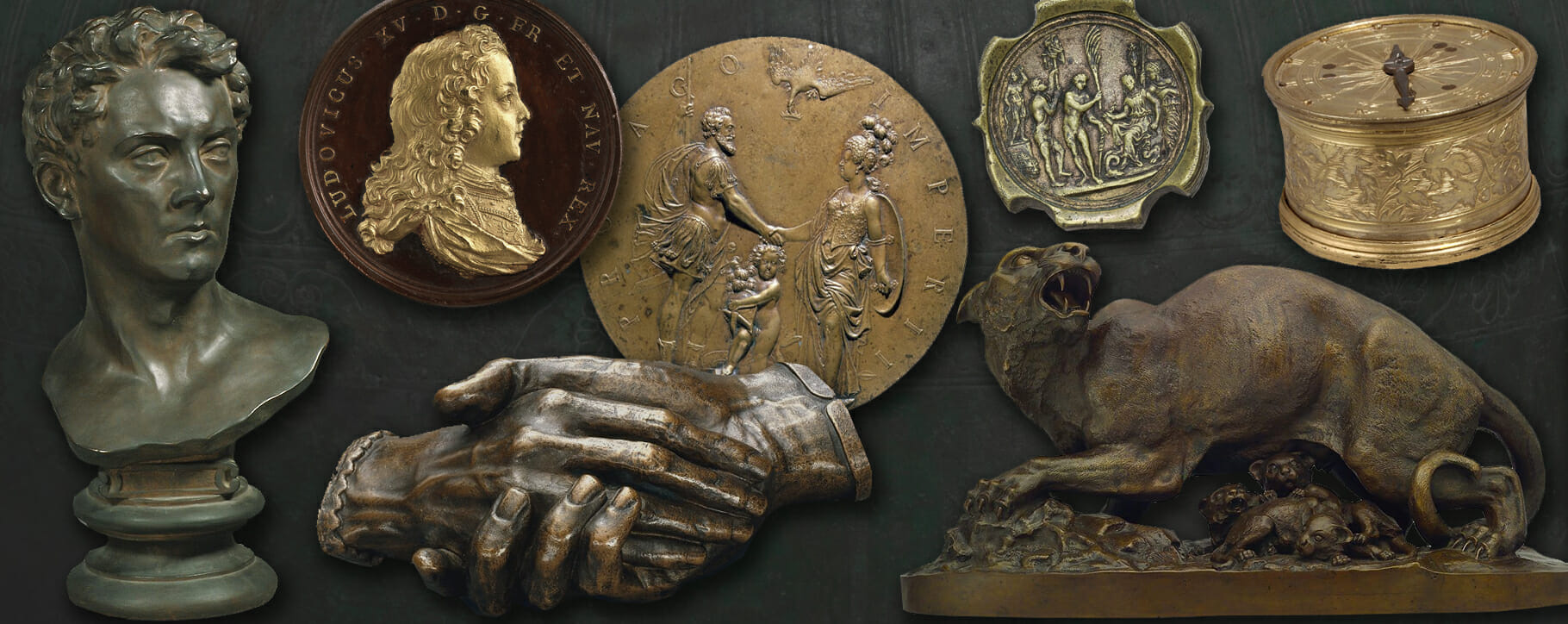 Above: examples of bronze antiques including a bust, medallions, clasping hand sculpture, statuette of a panther & gilt bronze table clock
Above: examples of bronze antiques including a bust, medallions, clasping hand sculpture, statuette of a panther & gilt bronze table clock 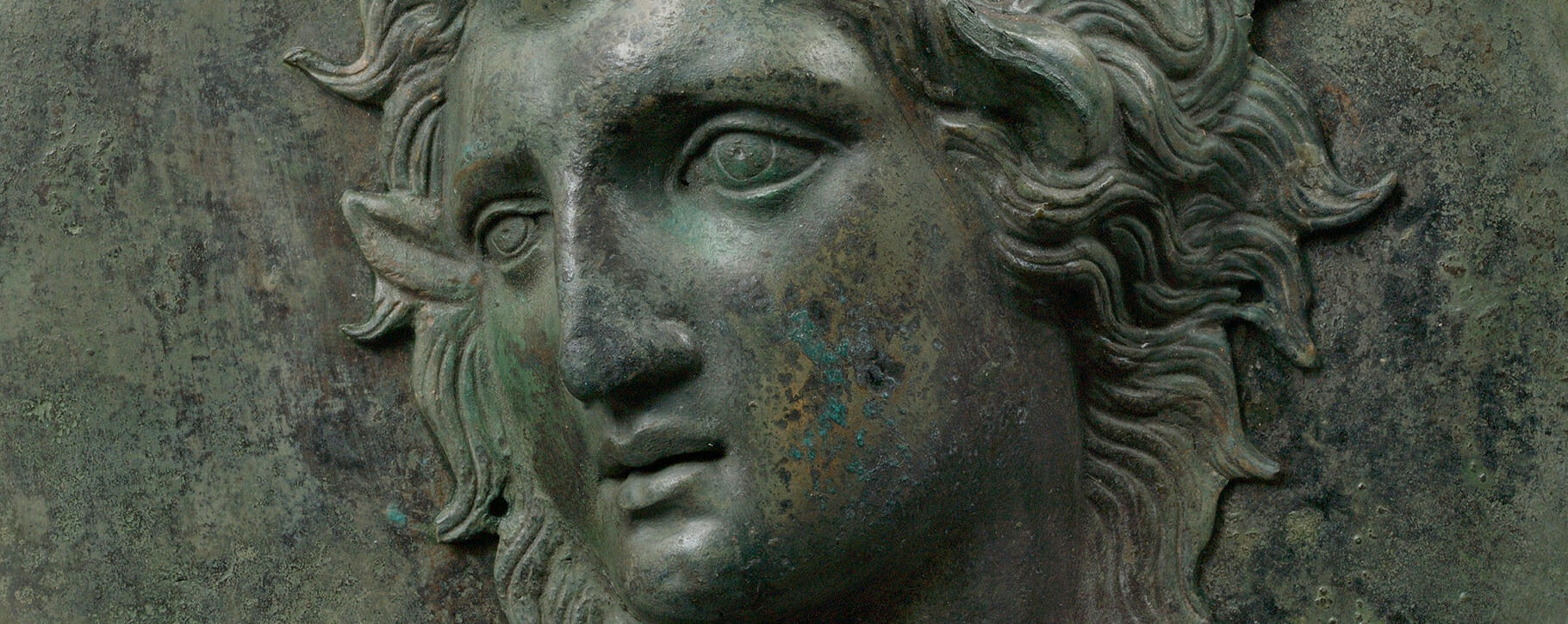 Above: a detail from a late 4th century BC box mirror with a youthful relief portrait of the woodland goat-god Pan
Above: a detail from a late 4th century BC box mirror with a youthful relief portrait of the woodland goat-god Pan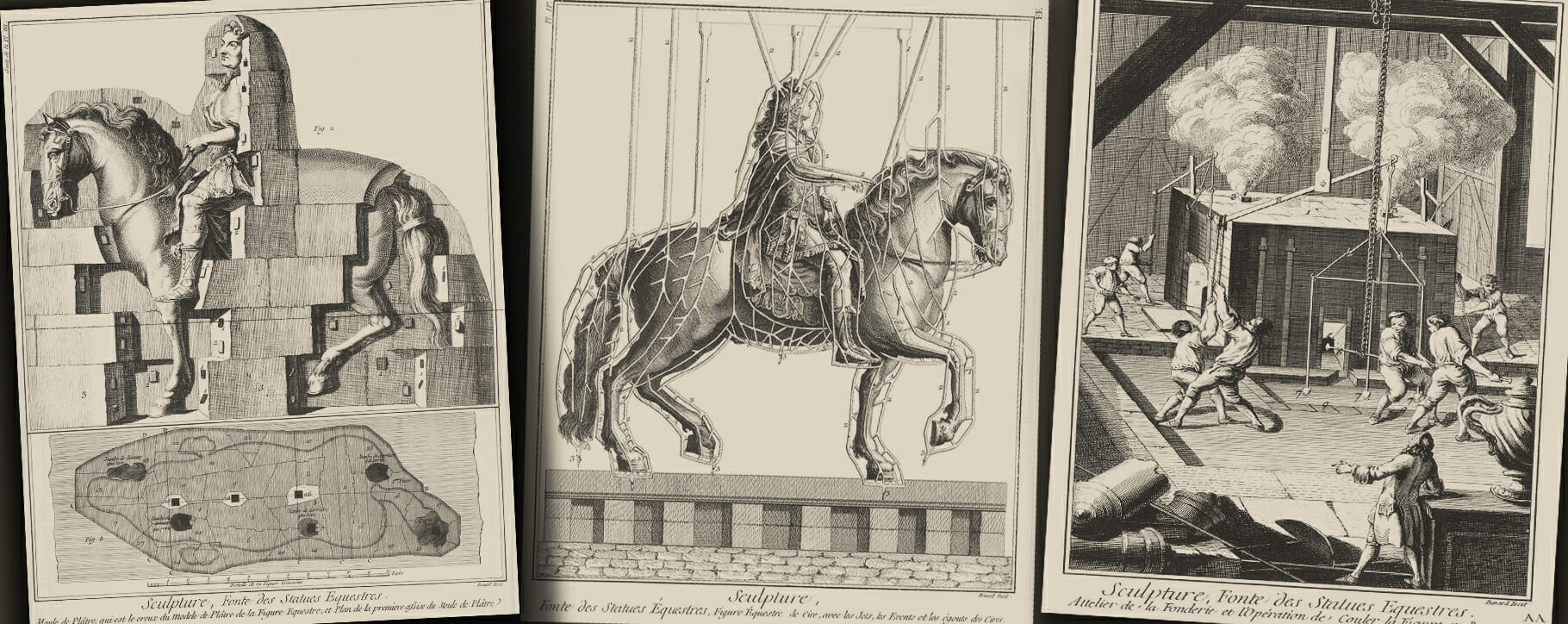 Above: engravings displaying the process of bronze casting, from left to right: the plaster cast process, a sculpture with support rods and wax drainage in place, and a foundry workshop
Above: engravings displaying the process of bronze casting, from left to right: the plaster cast process, a sculpture with support rods and wax drainage in place, and a foundry workshop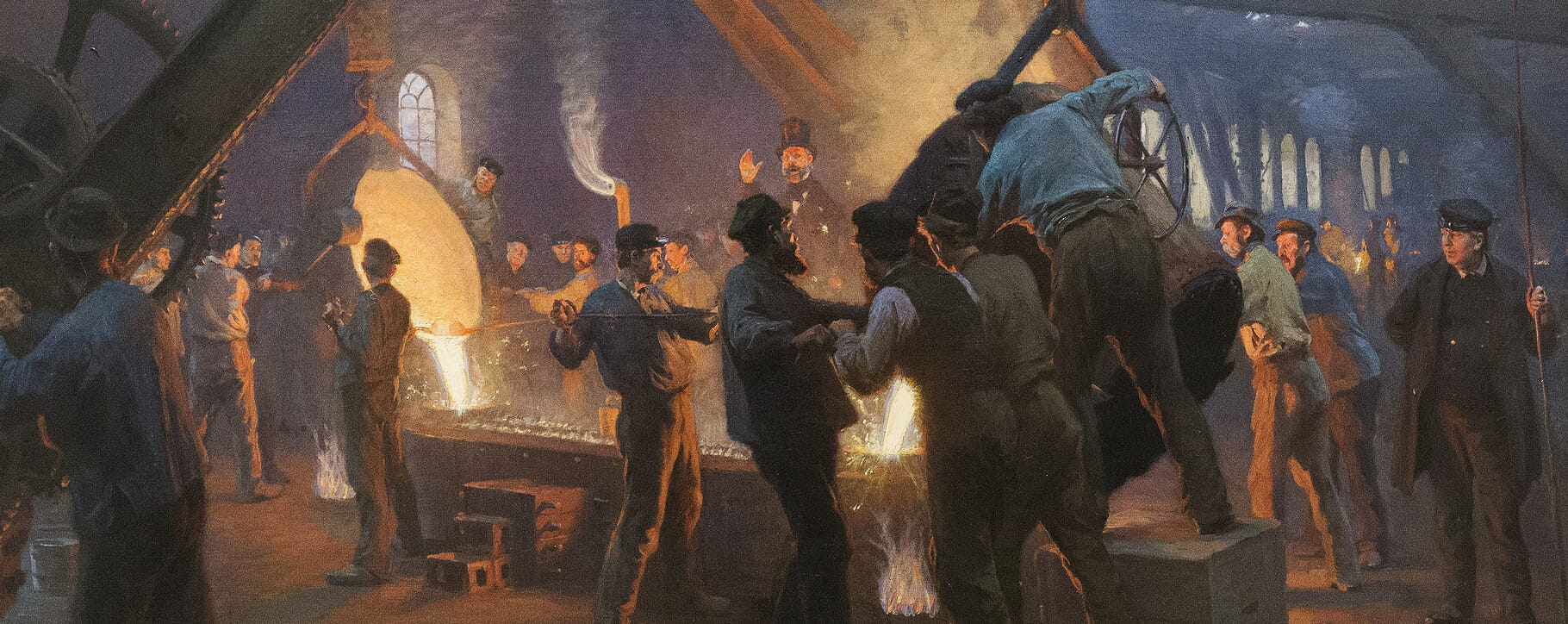 Above: a detail from a Peder Severin Krøyer painting of a working foundry, 1885
Above: a detail from a Peder Severin Krøyer painting of a working foundry, 1885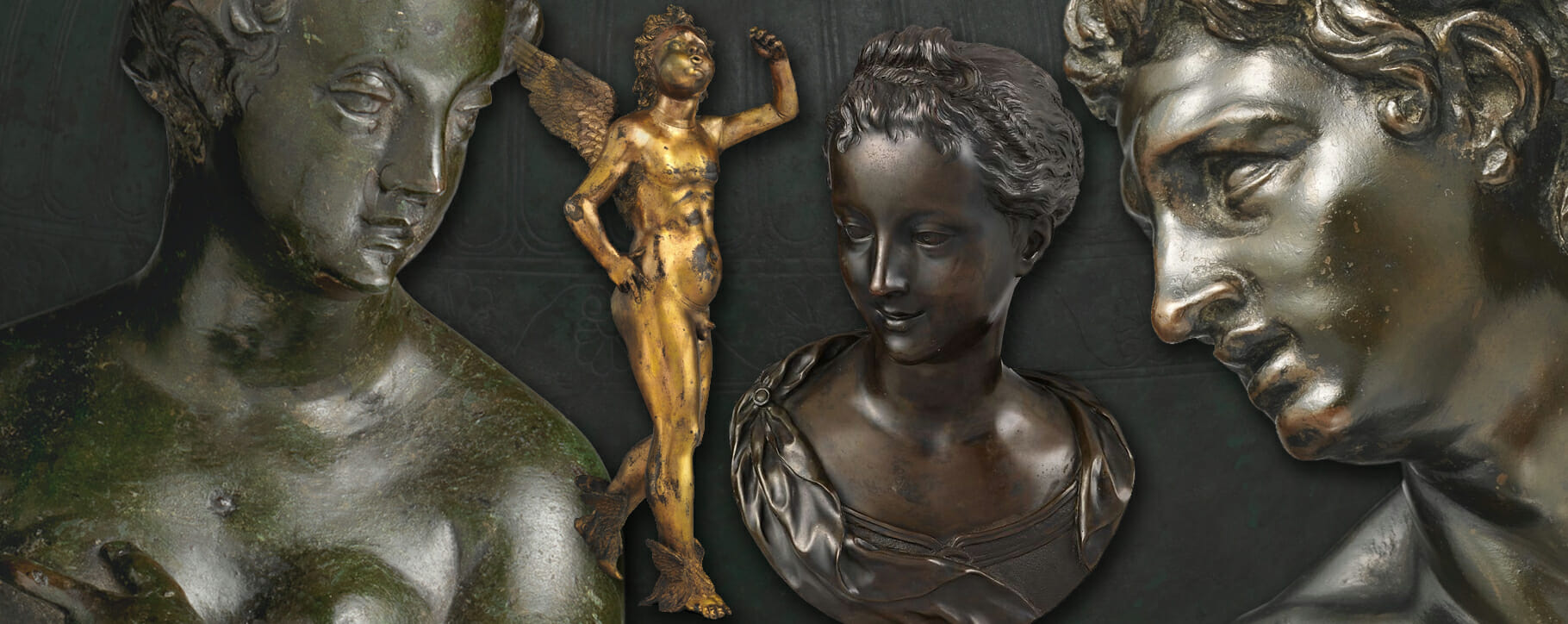 Above: examples of different patina colours you may find on a bronze, including warm brown, green and gilt finishes
Above: examples of different patina colours you may find on a bronze, including warm brown, green and gilt finishes 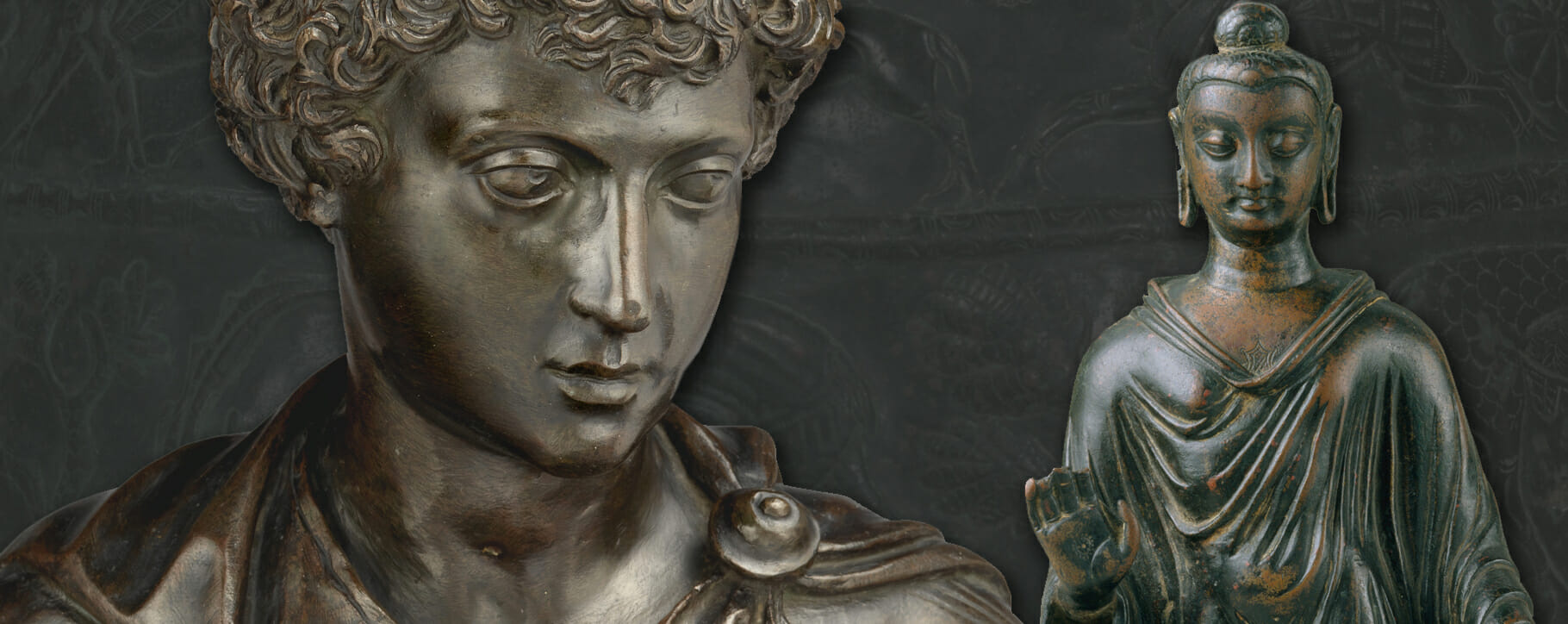 Above: a true bronze bust from the 16th century next to a brass sculpture with faux green patina
Above: a true bronze bust from the 16th century next to a brass sculpture with faux green patina  Above: examples of ancient bronze horse statues and a cinerary urn from classical eras
Above: examples of ancient bronze horse statues and a cinerary urn from classical eras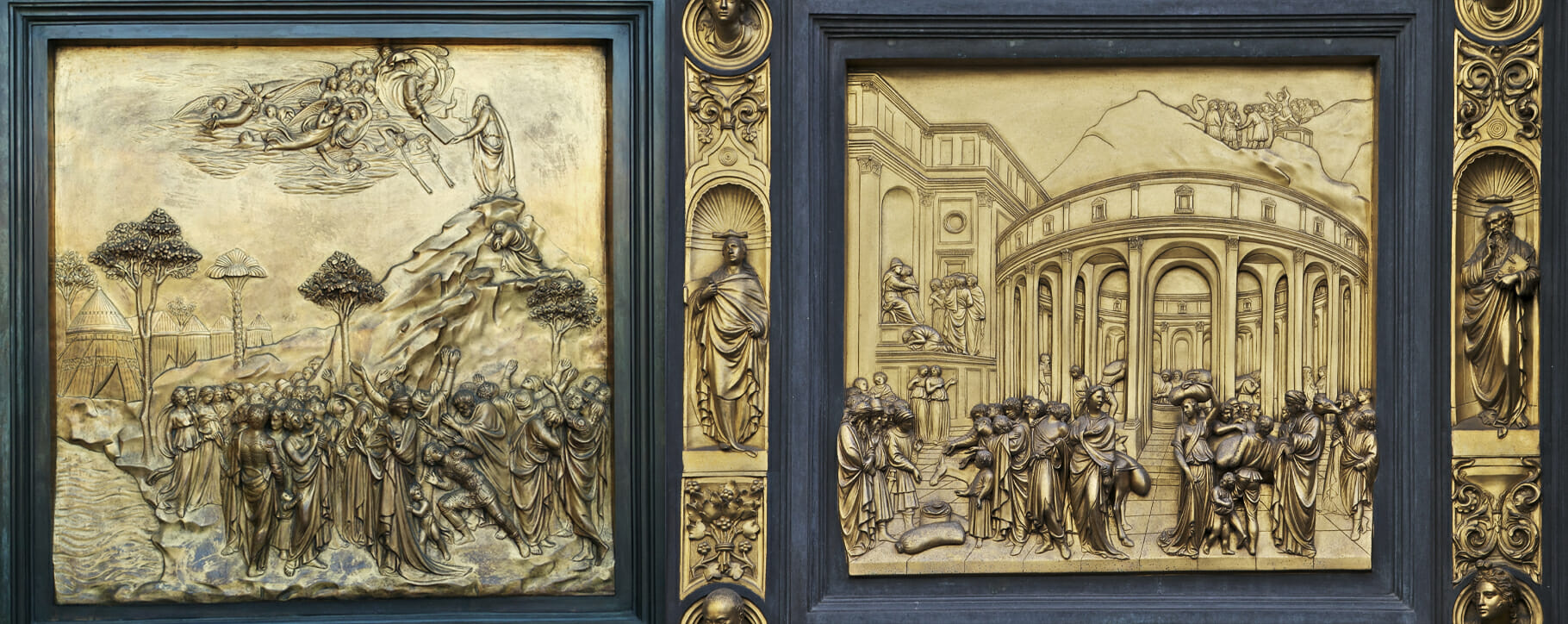 Above: details from Lorenzo Ghiberti’s Florence baptistery door relief bronzes known as the Gates of Paradise, 15th century
Above: details from Lorenzo Ghiberti’s Florence baptistery door relief bronzes known as the Gates of Paradise, 15th century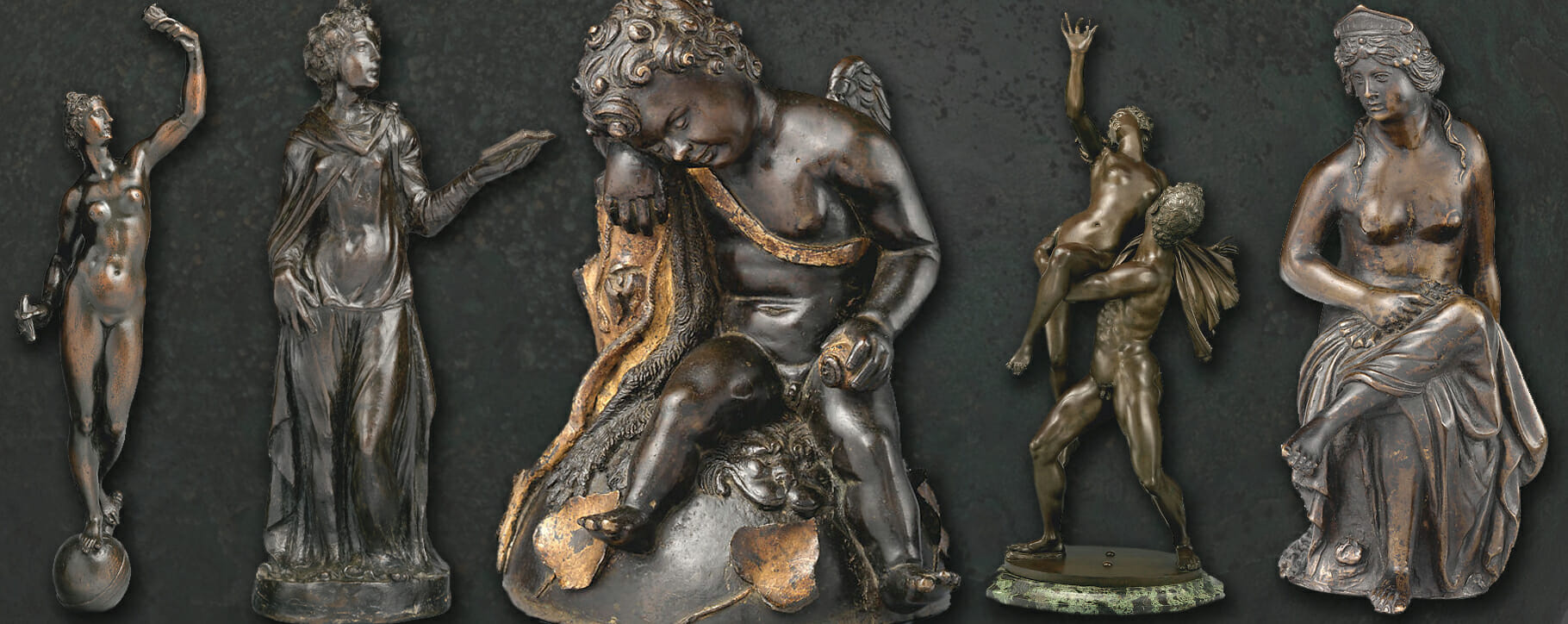 Above: a selection of bronze statuettes from the Italian renaissance period featuring typical classical allegory and characters
Above: a selection of bronze statuettes from the Italian renaissance period featuring typical classical allegory and characters Above: gilt bronze was popular in the baroque and rococo eras, this could be combined with dark bronze or even porcelain ornaments and is often found on clocks and candlesticks such as candelabrum
Above: gilt bronze was popular in the baroque and rococo eras, this could be combined with dark bronze or even porcelain ornaments and is often found on clocks and candlesticks such as candelabrum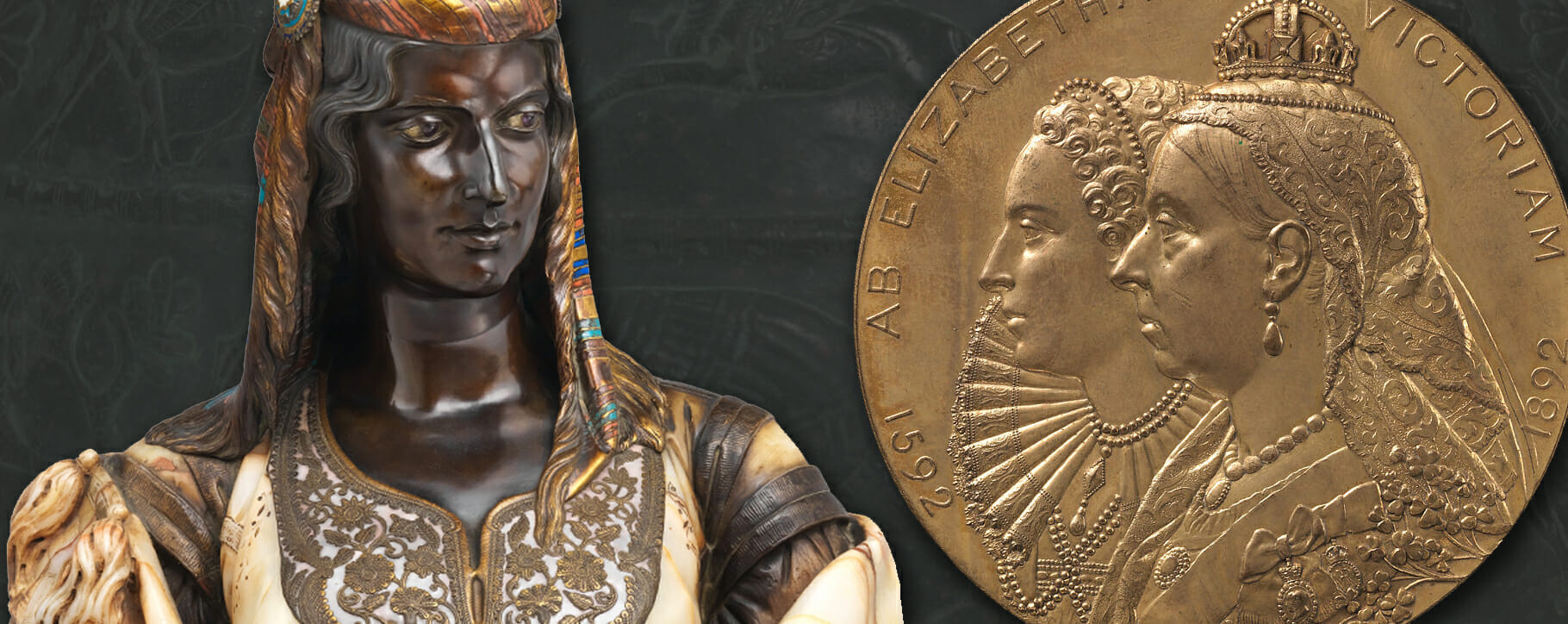 Above: 19th century bronze artworks – a polychrome bust with Algerian onyx-marble, bronze, gilt bronze, enamel, and amethyst eyes (left) and a medallion commemorating the Tercentenary of Trinity College Dublin in 1892 by Edmond Johnson
Above: 19th century bronze artworks – a polychrome bust with Algerian onyx-marble, bronze, gilt bronze, enamel, and amethyst eyes (left) and a medallion commemorating the Tercentenary of Trinity College Dublin in 1892 by Edmond Johnson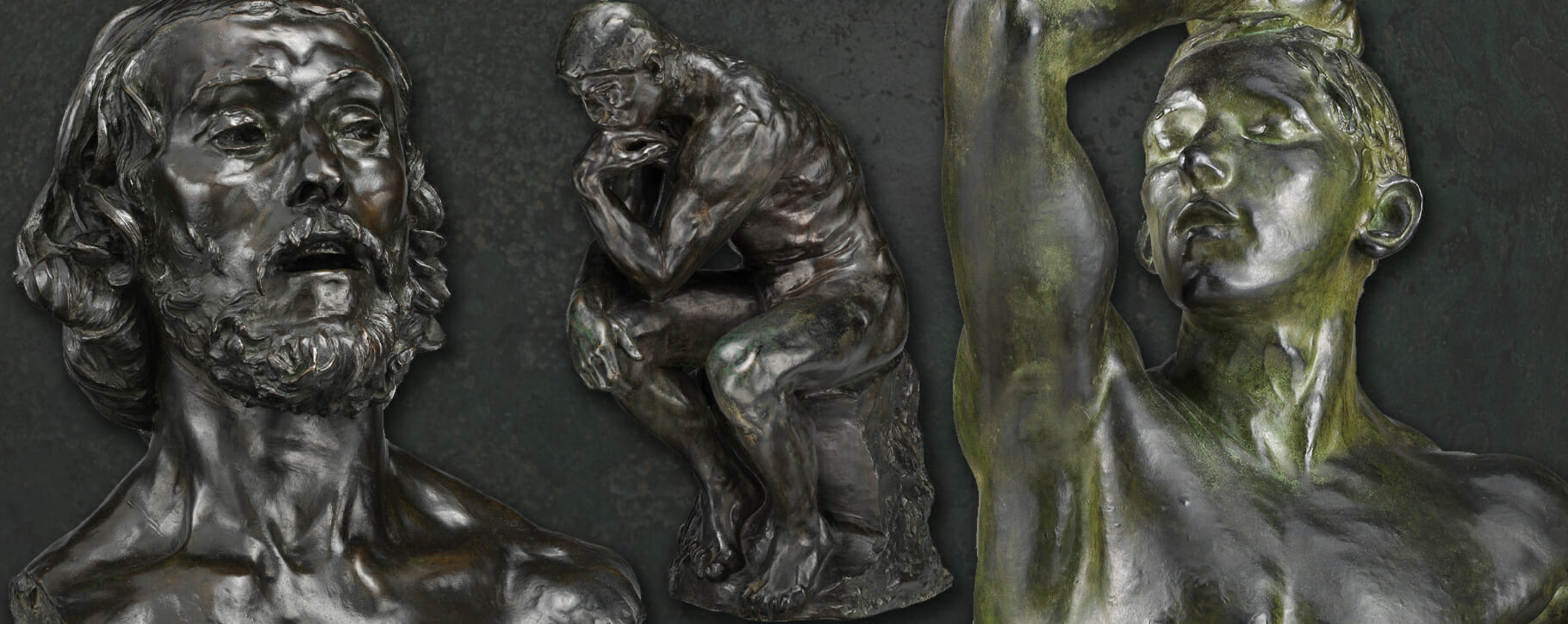 Above: examples of Auguste Rodin’s bronzes including St. John the Baptist (1883), The Thinker (1910) and The Age of Bronze (1906)
Above: examples of Auguste Rodin’s bronzes including St. John the Baptist (1883), The Thinker (1910) and The Age of Bronze (1906)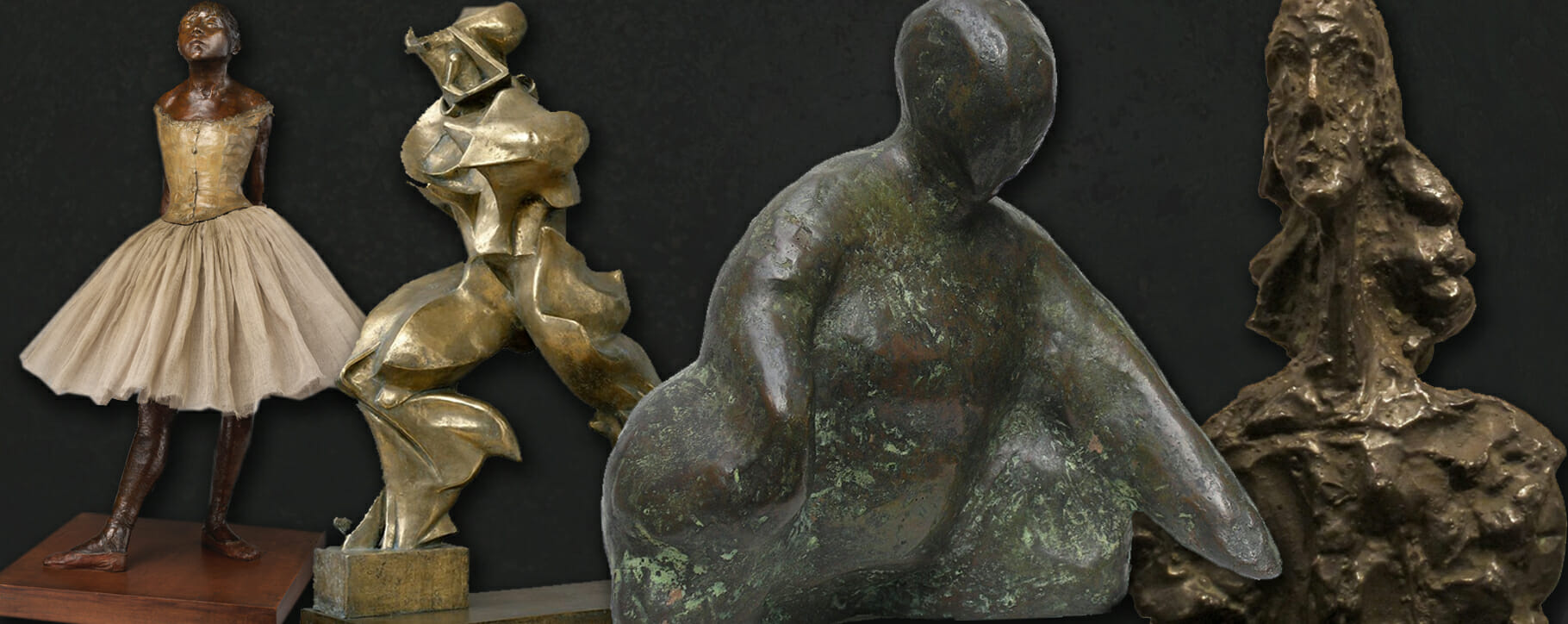 Above: modern and contemporary bronze sculptures including works by Edgar Degas, Umberto Boccioni, David Cregeen and Alberto Giacometti
Above: modern and contemporary bronze sculptures including works by Edgar Degas, Umberto Boccioni, David Cregeen and Alberto Giacometti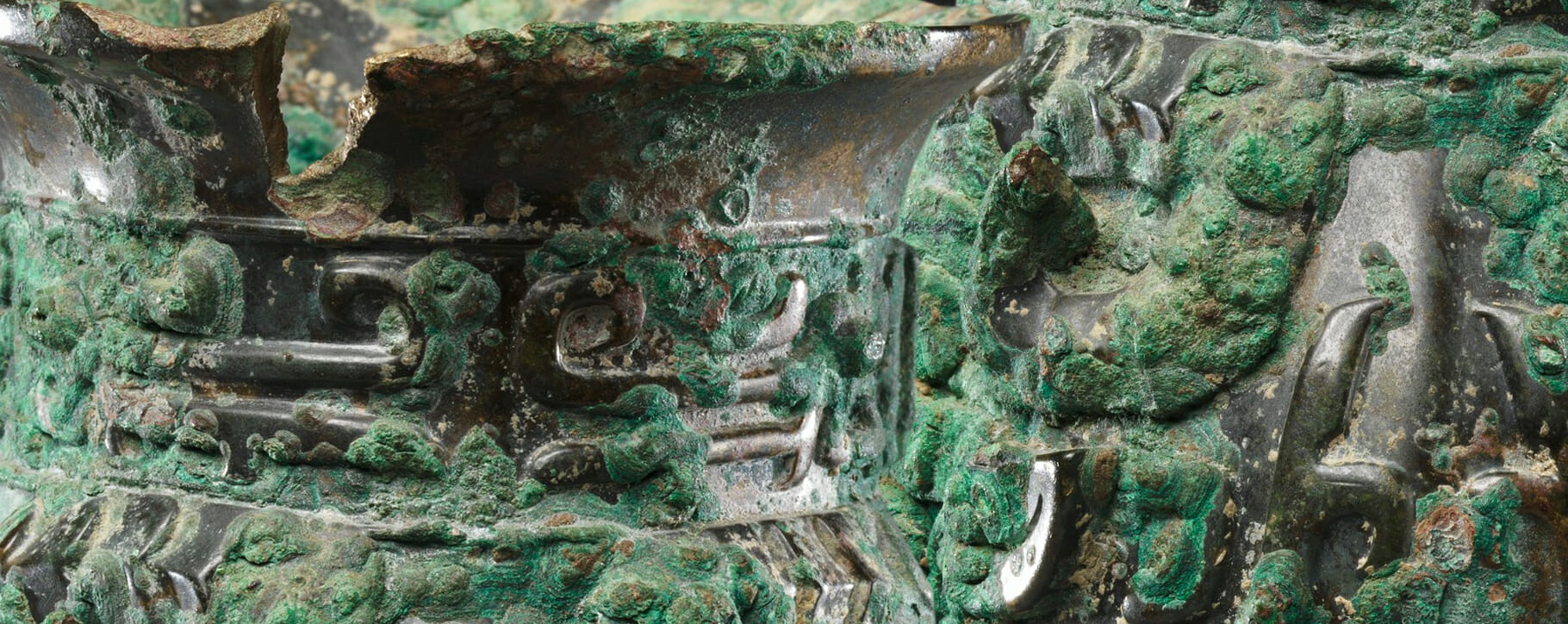 Above: corrosion on an 11th century Chinese cup
Above: corrosion on an 11th century Chinese cup 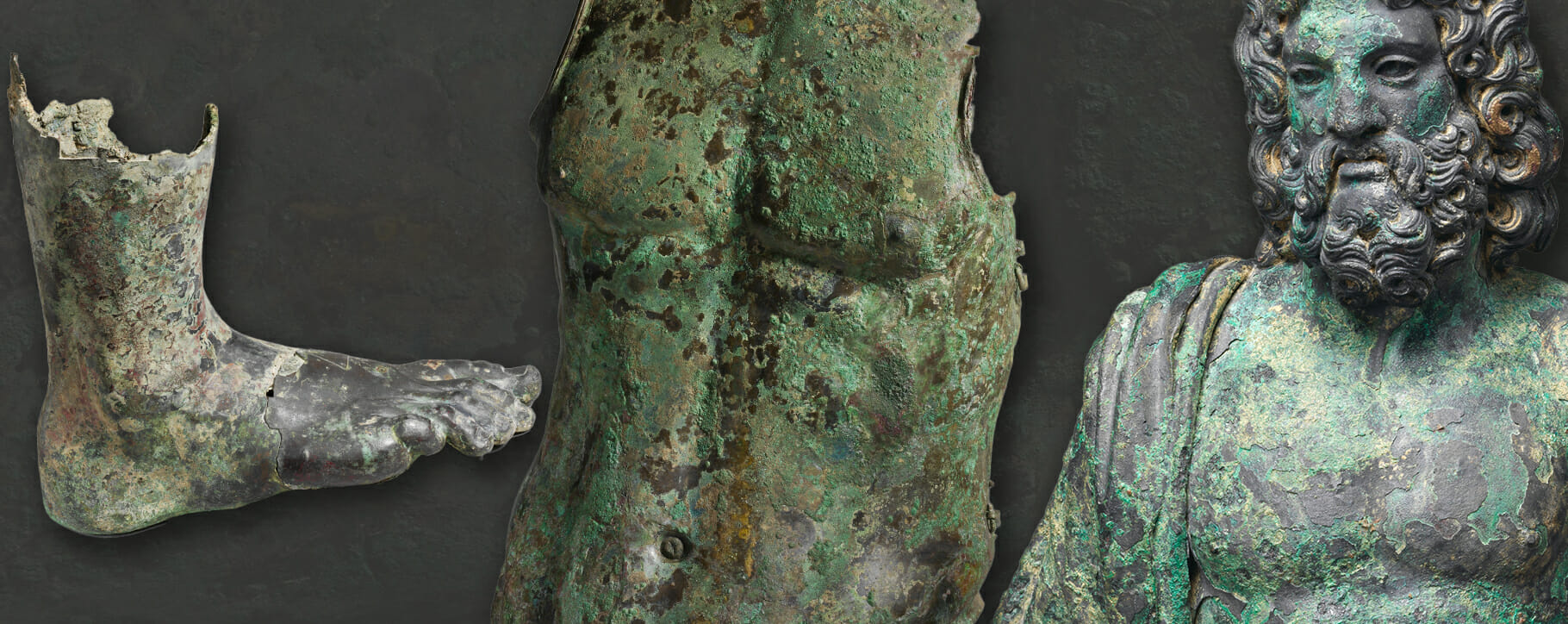 Above: ancient bronze sculptures with signs of corrosion due to their age and changes in environment over centuries
Above: ancient bronze sculptures with signs of corrosion due to their age and changes in environment over centuries 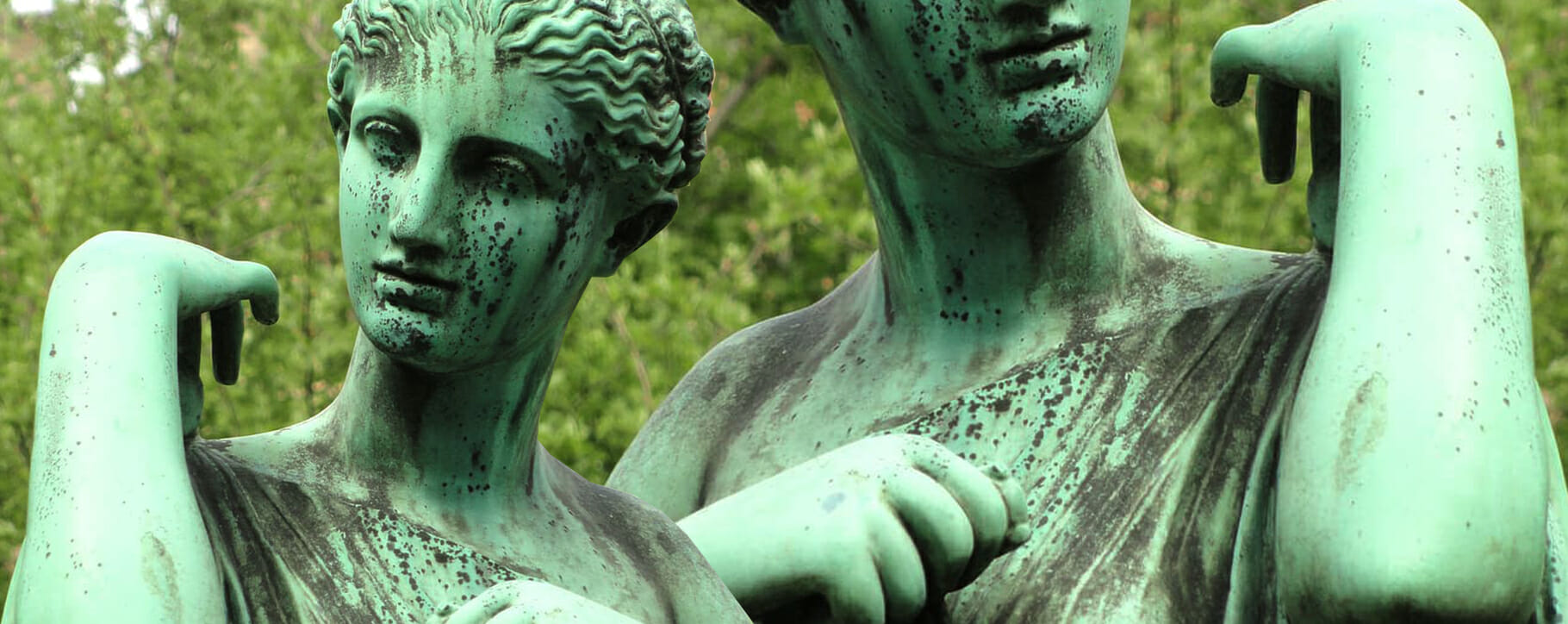 Above: a bronze sculpture with a typical green patina which has areas of corrosion from the atmosphere
Above: a bronze sculpture with a typical green patina which has areas of corrosion from the atmosphere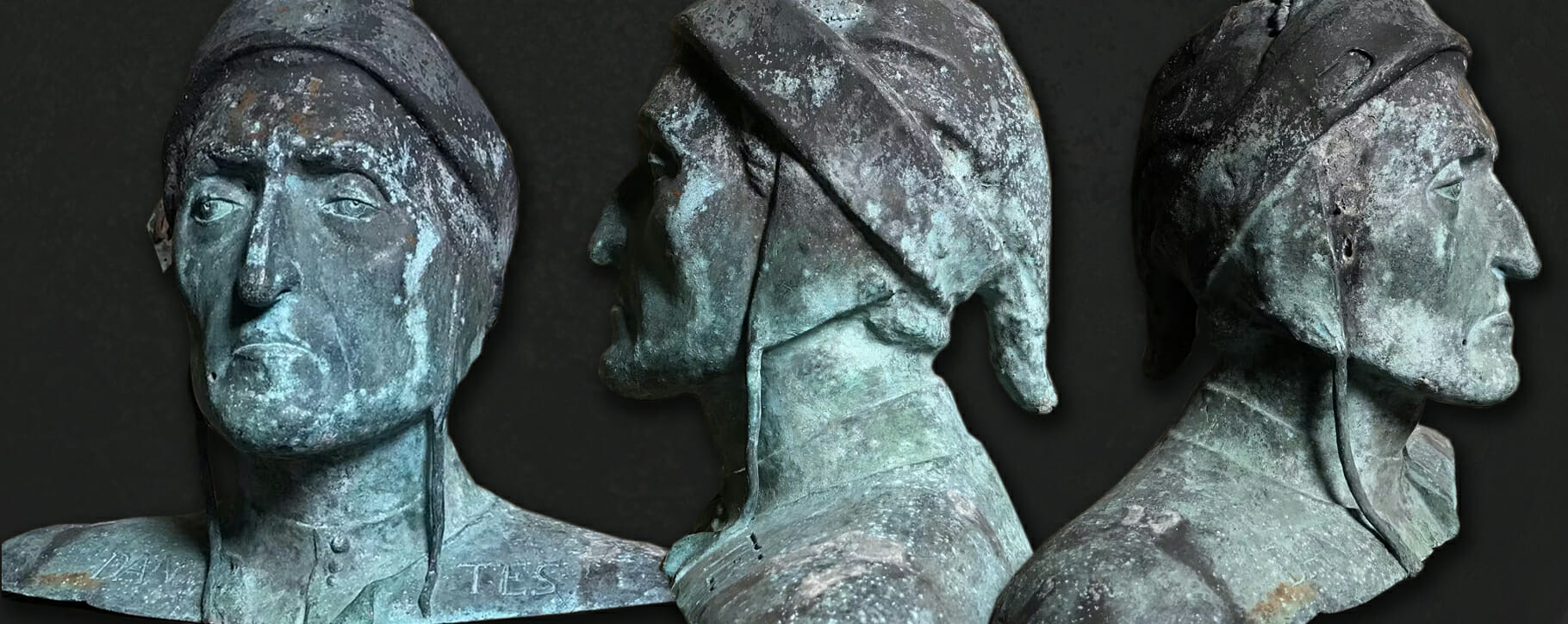 Above: the Dante bust before restoration work took place showing signs of deterioration
Above: the Dante bust before restoration work took place showing signs of deterioration  Above: the original bust next to the finish which can be achieved through professional restoration
Above: the original bust next to the finish which can be achieved through professional restoration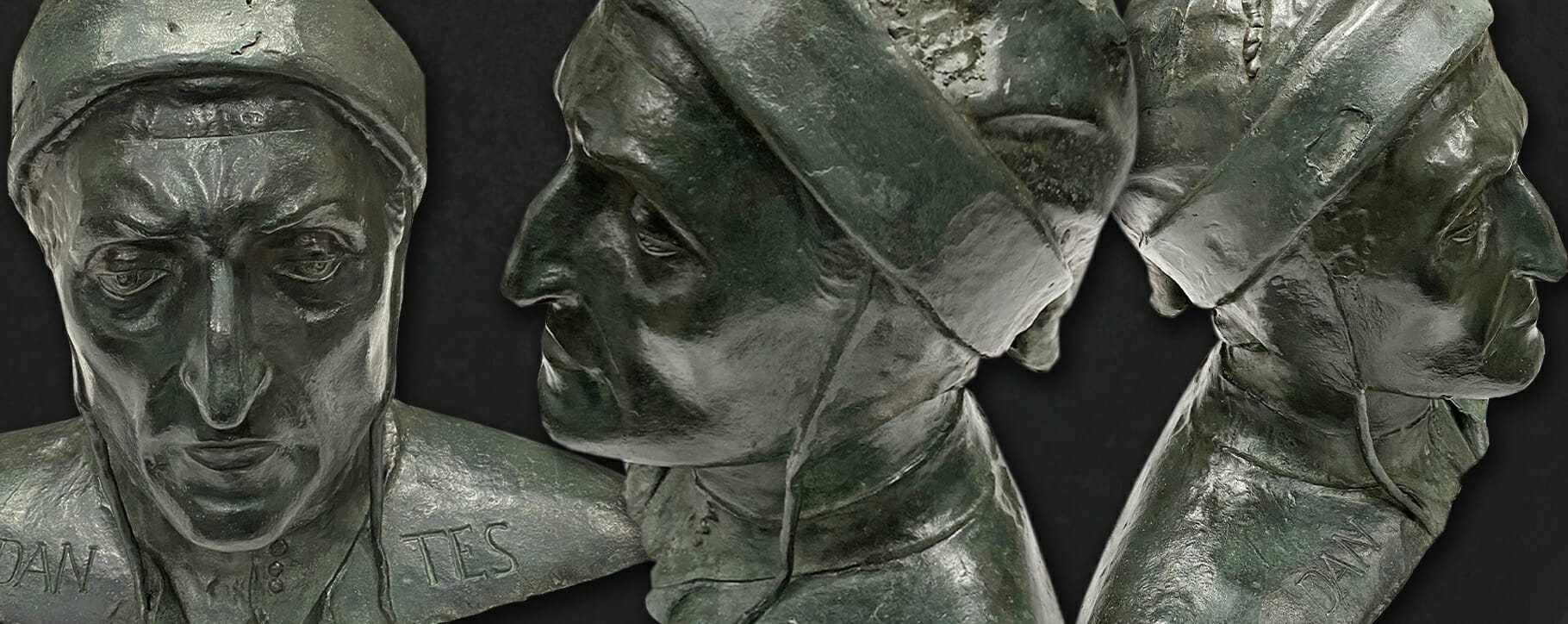 Above: the Dante bust after restoration work and an improved, stable patina in keeping with the original finish
Above: the Dante bust after restoration work and an improved, stable patina in keeping with the original finish




